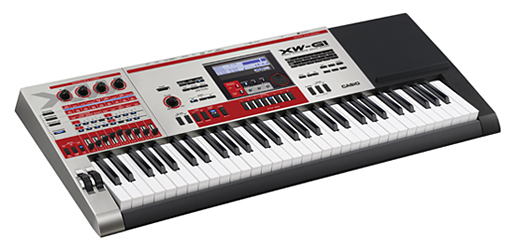What if a workstation arrangement keyboard were designed for DJs and synth rockers instead of, uh, whoever normally buys workstation arranger keyboards? Casio has taken the wraps off their new keyboards, and they appear to be affordable, all-in-one electronic beasts. Oh, except one of them has an organ. And an arpeggiator and step sequencer. So you can certainly step-sequence your drawbar organ, if you like.
There are also some retro-Casio CZ sounds, numbering in the thousands, loaded into these machines, so it seems Casio hasn’t forgotten why we loved them in the 80s.
And we hear the announcement via some charmingly-awkward headlines. They seem not so much lost in translation as something that makes me wonder what the original intent was:
A Groove Synthesizer with Many of the Cool Sounds and Features a DJ Uses in a Club
A Performance Synthesizer Specially Designed for Creating Sounds and Expressive Playing
That’ll otherwise be known as the XW-G1 and the XW-P1, respectively. I’m not sure which name is worse, so I’ll proceed.
I think all of this calls for celebration. Calvin Harris was echoing through my mind as I thought about CZ PCM waveforms:
Here’s what’s actually in these things.
A Groove Synthesizer with Many of the Cool Features a DJ Uses in a Club basically combines:
- A step sequencer with 100 pattern banks and 16 trigger buttons, and the ability to sequence multiple patterns together into bigger patterns
- A 100-phrase phrase sequencer
- Assignable keys (I think; here I get lost in translation)
- Solo synth (monophonic Virtual Analog) and PCM presets you can dial up
- Arpeggiator
- Sample looper with 19 seconds storage, overdubbing, and the ability to load samples as user PCM waveforms
- 61 full-size keys
- A “designated rubber holding space” – read, a mat that you can use to sit other gear on your keyboard
There’s 128KB of memory, but there’s also an SD slot, though it appears you can only use the SD to play SMF files.
You get a surprising amount of I/O: aside from USB, MIDI in and combined MIDI out/thru, you get a mic in, a line in, and a minijack line in. And the whole thing weighs just 5.4 kg (under 12 lbs).
The solo synth is truly monophonic. The routing appears to start with either a PCM or a Synth (hopefully Virtual Analog) pair of oscillators, or a hybrid (1 VA + 1 PCM), then route through filter and amp as expected.
There’s also a noise block, though, so you could presumably program some percussion sounds. And you can route an external input through the filter and amp envelope, via a pitch shifter, which is a bit more out of the ordinary.
There’s also a reverb, chorus, master EQ, and DSP block, though the DSP and chorus and Solo Synth all appear to use the same DSP.
80s jokes aside, in other words, this is not in any way an 80s synth.
A Performance Synthesizer Specially Designed for Creating Sounds and Expressive Playing is more or less the same synth, but with:
- “Hex Layer” for up to six-part combo “ensemble” sounds
- 50 drawbar organ presets
- 2,158 PCM waves, including presets from the CZ series (though I’m not sure if some of those CZ sounds aren’t also on the DJ model)
In fact, the Phrase Sequencer, Step Sequencer, and Arp are all in the “performance” synth, too, along with all the same I/O; it only lacks that loop recorder.
So, DJ version: 10 user wave slots and a looper.
Performance version: More presets overall, with the same synth presets, but “Hex Layers” for ensemble combos and some drawbar organ sets.
In other words, unless you really want to play a lot of organ or I learn it lacks those CZ PCM waveforms, you’d get the “DJ” version.
We know these are shipping in March and April, and that’s about it. I obviously need to pay the Casio booth a visit and find out if they’ll say anything about price, and get a look at these crazy-looking control layouts.
This NAMM, more than is even typical for NAMM, seems to fold back in time. I’m not sure if it’s 1978, 1988, or 1996. Or, at times, I think I may be at Macworld in the iPhone section.
I just wouldn’t write this keyboard off yet, as it might be some fun. It’s biggest challenge is going up against more-focused offerings from KORG that focus on pattern, looping, and other features. I’ll check it out.
Now, I’m just going to be very, very careful talking to US TSA airport security and Customs, because I don’t want to wind up in a “designated rubber holding space” on my way out of here Saturday.
Nod to Synthtopia, whom I’m fairly sure aren’t sleeping

